Cindy Abramson and Amy Becker: Creating A Community For Interfaith Families With JTown
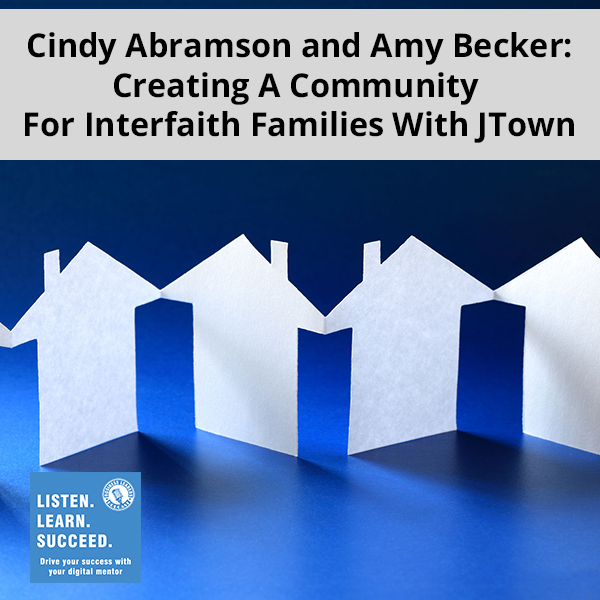
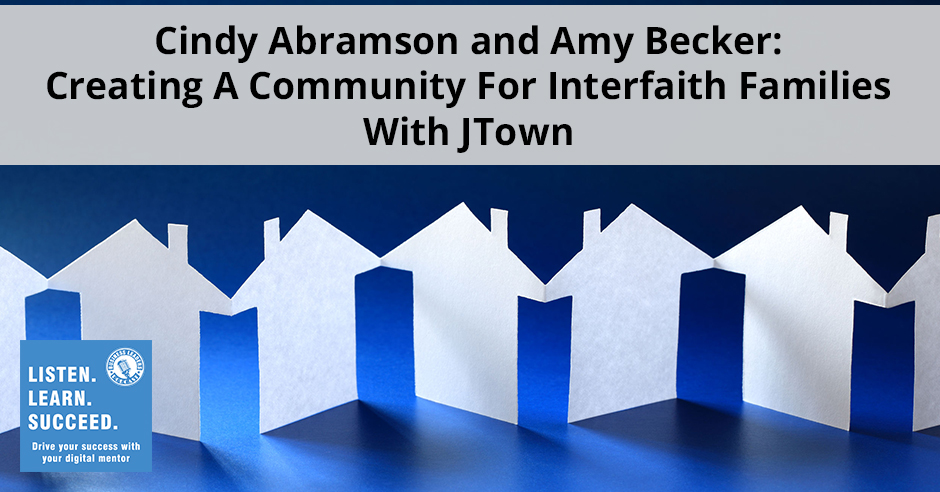
Judaism has changed a lot over the last few decades. Jewish families look a lot different than they have in the past. Interfaith families are growing and many people find it hard to fit into the traditional synagogue model. Cindy Abramson and Amy Becker saw an opportunity in this to create a community that is founded on support, acceptance, and love. They call this non-profit organization as JTown. With congregations being spread out, they offer a place where people can easily get together and inspire one another. They share what it means to be in a community and how they foster relationships and help those in need.
Cindy Abramson and Amy Becker: Creating A Community For Interfaith Families With JTown
We are incredibly fortunate. We have with us, Cindy Abramson and Amy Becker, Cofounders and Codirectors of JTown. Thank you so much for taking time out of your day to visit with us.
Thank you for having us.
Tell me a little bit about JTown, what it’s all about, who you serve and why you started it?
JTown is a nonprofit organization that we created to offer opportunities for people to create connections and community with other Jewish people. The people we say to people who share their lives. We have a lot of interfaith families and so we want the interfaith person to be as comfortable as the Jewish person. We created this place, there isn’t a place, it’s a metaphoric place. We don’t have a building. We say JTown is wherever we are together.
We have a lot of social things that we do for fun. We do a lot of community service. That’s a huge part of our mission. We offer a lot of team programming. Then we do some alternative worship services, which means that we do a Shabbat service once a month. We do High Holidays services and Passover and they’re all lay-led. We are leading them but we encourage everyone to participate. We typically will have five or six people come out from the community and take part in the service each time we do it.
As you were talking about why you did this since you we wanted to form a community, was there not a community available for these folks?
Judaism has changed a lot over the last few decades. Jewish families look a lot different than they have in the past. The research is showing that there are more interfaith families now than Jews married to Jews in the in the generations that are coming up. A lot of people don’t fit into that traditional synagogue model anymore. Also, we’re very spread out. It didn’t use to be like that. We used to all congregate in one little neighborhood or a part of the city. Denver has it sprawling, so our Jewish people and their families can become a little isolated and not have a place to be Jewish.
Amy and I worked together for about ten years at a traditional synagogue. We both left it at about the same time a month apart and spent a few months each of us looking for another job. It was hard because at our previous job, we had so much passion. We cared so much and we loved the people so much that we couldn’t find anything to replace that feeling in a work environment.
With your other job, what was it that you guys were in-charge of?
We did the administration of a synagogue. I was the Executive Director for some time. I have also been the Assistant Exec, Program Director, Preschool Director. Cindy was the Communication and Marketing Director. She had also worked with our religious school as the Assistant Director. We both had various roles over a long period of time. One thing that we were always passionate about was the relationships that we created with people.
You knew everybody. One way or another, you’ve been a director and what you did as well. There wasn’t anybody who walked through the door that you didn’t know, didn’t know their kids or didn’t know the family.
It’s a pretty large congregation and Amy was there for 23 years. She was a kid when she started.
Before we forget for the folks, we do have fruit drinks on board. We have the JTinis on board.
Everything has a J in front of it that you’re sitting in J headquarters. We have a J-dog. Then we both have mothers who are very supportive so they’re J-mamas and Cindy created this wonderful cocktail called the JTini.
People are going to want to know, what are the ingredient secrets?
Life would be better for just about everyone if they would make themselves a JTini.
It’s not they think it is.
A little trivia. This drink started out as the Amytini, which was a party for Amy’s retirement party. I wanted to create a signature drink for her. It started as an Amytini. Then when we started JTown, we made it our official drink. It’s a Deep Eddy’s Ruby Red Grapefruit Vodka. You can make it with soda. This is a loquat, a grapefruit-like club soda, a little lime and that’s it.
You’ve got to get your daily fruit.
Then I get my exercise going up and down the stairs.
Supporting people is not really about what you say; it’s how you make people feel.
You’re lifting those heavy bottles.
You have to drink it with a certain attitude like you’re going to conquer things.
You both have history, you had success and a community. Then you retired and you guys were out there searching for the next thing. Take me to the time where you guys were looking at each other and saying, “Do you know what we’re going to do? We’re going to form JTown.”
It was down here. We got together and were talking. It was hard to leave jobs that we were out for so long. We had a staff that was very close and was like our work family. It was hard leaving for a lot of reasons. We were getting together talking and it was like, “We have such this unique skill set. What can we do with this?” She was like, “We should do something together.” I was like, “No. I want to do something different.” She started to talk about creating what we were missing most about where we came from, about the relationships, the people and the importance of offering these opportunities for our community.
When you formed this, you went through the drill. You read your 501(c)(3) application and you got squared away. What did you do?
This is such an important piece is that we sought support from people we knew. People who knew us and could help us, could be resources for us, and who also would be honest with us if they didn’t think what we were thinking would resonate. We had some wonderful support. Those people have basically become our board. They helped us apply for our 501(c)(3). They’ve helped us with our mission and have continued. We’re blessed by that. That’s what helped us get our start too.
You’ve got some positive feedback from the folks, your advisory board. You’ve got that and you go, “Maybe there’s a need.” Because I’m assuming that you responded. When you went out for your first marketing effort to see if people were wanting to take and participate with JTown, what reaction did you have?
Some good and some not so good. Part of it is that it’s a little hard to explain what JTown is. A lot of people thought we were trying to open another synagogue. That’s not at all what we are trying to do. The people who are still around and especially people on our board loved the idea. We were pretty far along and we went fast. I think it was 90 days from conception to our announcement and commencing the business. We didn’t get our 501(c)(3) that fast.
After six months we had our 501(c)(3), which was pretty miraculous.
It didn’t sound fast but compared to fourteen months to two years, it’s fast.
We were lucky they accepted it the first time.
We have some good advice. Amy and a couple of people on the board worked very hard.
Do you guys keep track of the members in JTown?
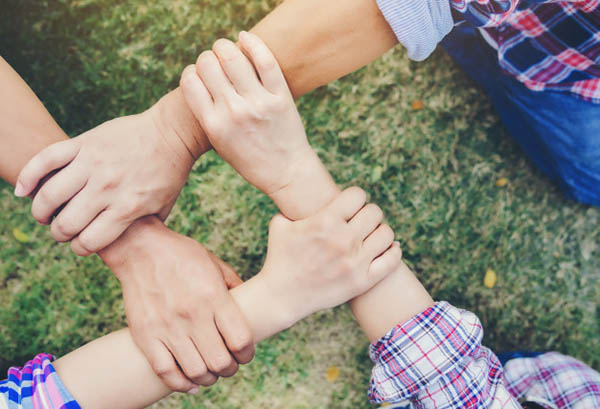 Creating A Community: It’s very important to seek the support of people who could help and be resources to you that would tell you honestly what does not work.
Creating A Community: It’s very important to seek the support of people who could help and be resources to you that would tell you honestly what does not work.
We’re not a membership organization. We have something we call a JTowner fee that offers discounts and tickets to our High Holidays, which is our most important set of worship services during the year. People can receive those tickets and discounts. If they don’t, they can still participate equally. They’re not seen any different, but they don’t get the same frequent flyer miles as we put it. It’s worked well. We do have over 100 households now who are JTowners or pay that fee, plus probably another 50 or 60 households who participate in what we do. It’s growing all the time.
The reasoning behind that is we don’t want people to feel like they have to pay to be a part of a community. If you come, you’re a part of what’s happening and each thing we do is a community thing. You don’t have to make a financial commitment or any membership commitment. We think that that model is very different. It’s taking a while for people to understand that. Hopefully, I think that it is getting to be more well-known.
This is what you are doing between the two of you pretty much all the time.
Full-time plus.
When you look over from the start and you go, “I wish I’d known that when I first started.” Have you had any of those moments?
If anything, I wish I would have known the reaction that’s been so positive when we started. There were times at the beginning where you’re considering, “Are we doing this the right way? Are we taking the right approach?” What we’ve found out is that all the things, all the way we set up our mission and our goals is resonating with people. It’s not any doubt that we’re going to make it, which is exciting. We used to do percentages.
In the beginning, I was a little skeptical. I was like, “We have a 10% chance of making this work.” Then she checks in with me every now and then, “Where are we at?” In a year, we got from 10% to 100%. It was scary and it was risky. If we could have known a little earlier that it would work.
Creating the culture of welcoming is not just about welcoming somebody as they come in. It’s also about saying goodbye and knowing they’ll come back.
We don’t have any regrets from day one until now. It’s been fulfilling for us as the staff people are fulfilling for us as participants in the community. Our families have engaged with it, our husbands have supported it and been not only our biggest fans but have worked it with us in many ways. My teens are involved. Cindy’s kids are so supportive and one plays on our softball team. That means something when you have that support, not to mention our mothers and our parents. We’ve been very fortunate very blessed to have that.
Looking out to the future. How do you see the organization changing, morphing or going into the future?
I think that it’s going to be the people who come. We want the people who come and participate to be the ones that plan the future. We try to facilitate that. We always have our fillers out for what people are saying and what people are wanting. Then we think through whether we can make it happen successfully or not. It’s why we started slow and added things slowly because we want to know that we can do it and do it right. Let’s say we have a bunch of young families who want to start something together, that’s for young families in particular, which what we are starting to do. Then we’ll go that direction with them.
When you first started out and you said, “We’re going to provide this particular thing for our community.” What was that?
It was a hard time because I’ve been a member at where I worked since I was six years old. I didn’t know anything else as far as the Jewish community. The High Holidays were very closely coming up. My dad had been very sick in the last few years of his life. He couldn’t sit in services. It just was too much and it was too hard. There were several years where our little family would take chairs and we’d go to a park. We’d sit in a circle, we’d go through the book together and we’d do our little service. It was like, “Maybe we could do something like that and maybe there are other people that don’t necessarily have somewhere to go. Let’s see what happens if we have 50 people. We are going to be thrilled.”
We have 230 of our three services.
You over-succeeded.
Our first set of services, a man walked in that I had known and looked at me and said, “I’m lost.” It directed us many times back to why we’re here. I looked at him and said, “No, not anymore.” Who knew at that moment where we would be that man has been to every event that we’ve had with his beautiful wife. It has motivated us in such a way. We support the people that come in so many different ways. The saying about it, “It’s not what you say it’s how you make people feel,” that’s what Cindy and I focus on. We could have the most amazing program that is spectacular, perfectly directed and presented or we could have the worst. If people have a good feeling when they’re there, they feel accepted, welcomed and included, that’s what they’re going to remember. In addition to some of the other details, but we believe that no matter what you do. If people feel good about being there, they’ll be back. They keep telling us, “We’ve never had this feeling before,” which is unusual.
For the folks out there going like, “What do I do to create that feeling?” We hear that and you go, “That’s nice. I would like to do that.” What did you guys do specifically to start trying to create the atmosphere or a culture of welcoming?
 Creating A Community: No matter what you do, if people feel good about being there, they’ll be back.
Creating A Community: No matter what you do, if people feel good about being there, they’ll be back.
Initially, it’s part of both of our personalities in general. A lot of people say this but we don’t judge. We believe that everybody is on their own journey. Everybody has their own Jewish identity. It’s all fluid and so we accept people where they’re at. It doesn’t matter who they’re married to, where they live, what they look like or how much money they have. None of it matters. You’re welcome here. We try to be accepting of people for who they are and be friendly. We always make a point to remind people that this is our community so please make sure you introduce yourself to people that you don’t know because it’s not just our responsibility, it’s everyone’s responsibility to make this feeling. It just can’t be for Amy and I.
When you say that to them, do you see them behave differently? Do you see them introduce themselves around?
We do. We give them hints and expectations. When we start a worship service we say, “You have only one job to do and that is to introduce yourself to other people.” When you’re in line at dinner or you sit down at the table, meet each other. This is what makes the community work and they do. It’s like, “Thanks for the direction.” Then they’re off and running. It makes it much easier for Cindy and I work our way around the room. We also try and be very aware of everybody. We look around the room and when somebody’s not sitting with someone else, we will sit with them. We are out to make everybody feel good.
Do you guys have the gift of when you walk in a room by the time you’re done, you know everybody in there?
It depends on the room and the vibe. Cindy talks about the vibe a lot.
Your vibe attracts your tribe and I didn’t make that up, I actually heard that and I loved it. It was a couple of months in and I’m like, “That’s exactly our mission is to create that vibe.” We are tracking this tribe of people. We usually have 50 or 60 people at our Shabbat dinners, which we have once a month. We have one long table always. It’s one community and we’re all together and it’s different people. Some people come every time. We usually have at least a few new people every time and so it’s a mix.
You go to various meetings and the people that know each other and they always take and go hang out with the people they know. That’s the biggest problem. That’s not my nature. I’m not going to know everybody in the room. By and large, I’ll go stand off to the side. This lady came up and said, “I saw you standing over here by yourself. I always made a point to find the one person standing by themselves and go talk to them.” Since that time, I’ll go to the place and I’ll look for that one person.
Is that hard for you?
It’s out of my comfort zone.
It is for me as well because it’s not in my comfort zone to go walk around the room, schmooze and introduce myself. It’s getting easier and I am doing it over and over again. I’m usually the one in the corner.
Not anymore. Also, we’ve also found that it’s not just about welcoming somebody as they come in, it’s also saying goodbye as they leave. It’s being aware that they’re leaving and asking them to come back. We would love to see them again. That’s as important as anything we do.
Sometimes your best thoughts come in the most unusual places.
It’s like welcoming them into your home. That’s quite the mission for you to come out of where you’re at and say we’re going to take in. I think about you’re trying to solve a pain point effectively. If you guys felt it, heard it, there was a need, somehow or another you felt moved to point to solve the pain point. Either we think it’s there then you execute and the board must have thought so.
We spent a lot of time, weeks, talking about what we called our whys. I know that’s not our original idea. We watched something that talked about how important it is to do that first. It’s not a natural way because usually, you want to go, “Here’s what we’re going to do and here’s how we’re going to do it.” We started with why. We have a whole list of our whys and we always go back to it. That’s our song. That’s the Laverne and Shirley theme song, Making Our Dreams Come True. That was a gift to me from Amy. We used to sing that on days when we were worried, but we don’t have those days anymore.
When you start with those whys, it helps us pinpoint, focus on and come out of the gate with things that we had a chance of being successful.
What are you getting from the interfaith families?
It’s fairly positive. We have people who are Jewish participating with a Jewish spouse and people who are participating who have a non-Jewish spouse. We have some of those non-Jewish spouses involved on our board. We accept everybody and include everybody as an equal. It doesn’t matter. Not having those labels is important. Our world is filled with labels and it’s a discredit to what you’re doing. We are trying to do away with that and just make it about people.
We were talking beforehand that you have a project coming up. This event is going to happen in November. It is called Project Our Town. Let’s talk about Project Our Town from how you came up with the idea to what you’re trying to accomplish.
It started in the shower for me. Sometimes you do your best thinking in the most unusual places. Cindy and I both had an experience similar to Make a Difference Day, Community Service Days. We got together that particular day and started talking about that. Before we knew it, we were creating this magical community service opportunity with several goals. One goal is to go out in the community and help those who are either underserved or living in some unfortunate circumstances or people who just can’t help themselves. That was our main goal. What we found is that we can do a lot of different things, set up a lot of different projects that we could then invite potential volunteers to come and do alongside. We started with a small council that we call Leadership Council. We delivered this idea of Project Our Town. We have over 50 volunteers working towards this November 10th and 11th. The other idea behind Project Our Town is that we want people to not be intimidated by volunteering for agencies.
We want to educate people about the good that’s happening in our greater community and how there are so many more agencies than you could ever imagine. We want to educate people and encourage them to continue volunteerism. It’s a multi-fold event. We’re trying to accomplish a lot of things, in addition to helping people. Along the way, we’ve planned drives. Every month, we’ve had a different drive from a food drive to toiletry drive. We’re doing a backpack and school supply drive. All of the things that we collect are packaged and sent to those who are in need.
 Creating A Community: Our world right now has so many labels that it discredits people of what they are doing.
Creating A Community: Our world right now has so many labels that it discredits people of what they are doing.
For the folks out there who go, “We’d like to do something like that in our community,” when you talk about organizing a drive, from thought process to planning, to who’s the champion in execution, can you talk a little bit about that?
You’ve got to start with some passion and determination. You have to put some work into it. It’s something that can be done on your front porch at your place of business, at your children’s school, approaching the right people. We have the gift of social media, which has been wonderful. If you have a lot of people that you connect with whether it’s Facebook, LinkedIn or Snapchat, any of those you use them to your advantage with collection. It’s deciding what you want to do and who you want it to go to. Then approaching the right people to support you.
How do you know who the right people are?
If you’re at your place of business, it’s involving your HR department and asking them to put the word out to co-workers. You’re promoting it and using your work-life as a benefit to all of these people. For me, I wanted it on my porch, so I put the word out on my neighborhood Facebook page and asked people to bring things which they’ve done. We have some other people on our leadership team that have done that and been very successful. We also have two businesses, Baker’s Way and Bullock Mortuary who have bins in their places of business and they’ve helped us to promote. We’ve promoted that anybody can drop things off to them. We engaged the community that way. It’s been great and successful and it’s growing.
We use consciously who we want to deliver the items to that we collect. We’re trying to find organizations that maybe don’t get as much support as some of the bigger organizations.
Then our weekend on November 10th and 11th, all day each of those days Saturday and Sunday, we will have volunteers going in groups and teams out into the community to fulfill projects, which all of the volunteers would have pre-registered for. We set them up on a team and there’s a team captain. We anticipate having 80 projects and over 800 people that weekend. It’s an annual event that we will be doing every year.
I think about the team leader in the project. What’s the range of projects that you are going to be doing on the community?
It’s so great because we’re able to be creative. We’ve been going to organizations and putting together with them like what would help you as opposed to coming in with our own ideas. We had a call with the mental health center of Denver. We were able to put together at least five projects. They have a house where they home homeless people. We’re going to have a team of people go in, make a meal for them, and do some social things with them. We have a couple of projects like the Denver Children’s Home, which is a residential and day treatment facility for some of Colorado’s neediest kids. These kids are abused, neglected, with serious mental illness.
We’re able to go in and do something with those kids. We’re going to do it each Saturday and Sunday. We’ll have some fun activities. We’re going to do some art projects with another homeless place. We’re going to ask them to create cards to give to another organization. They may create cards. They’ll send them or we’ll send them to the veterans or people who are overseas or children. To give them the opportunity to help someone else is always very empowering. We’re trying to mix and mingle.
We have things and projects planned that people can do in their home if they can’t get out. We have things for people who are a little shyer about going to an agency where we house our weekend. We have all kinds of opportunities for all different ages. We’re excited. We’ve had some businesses reach out to us and said, “We’d like to send a team of people. We like to do social action work.” That is exciting for us. The whole idea, it doesn’t matter what religious denomination you are, anybody can participate in there and are more than welcome to.
Anybody’s working side by side because it doesn’t matter where you come from, what religion you are. When we all come together like this, it’s just like magic things happen. People are more than ever looking for something to do because things in our world are upside down. Sometimes we feel helpless. It’s been our way of easing our feelings a little bit.
When I grow up as a kid, I knew everybody in the neighborhood. I know you did and you went outside and played. You didn’t have social media as much as it’s supposed to be empowering, I think it’s isolating. For you out there, people making friends and getting to walk on somebody else’s shoes a little bit. You guys have a strong belief system in your organization. As you’re going down the road and as you get more mileage and understanding, does your core belief of what you’re trying to do changed or been strengthened by what you’re seeing on your journey?
If you want to feel good, do good.
It’s been strengthened. Two words that always seemed to come up are we want to create things that are meaningful and relevant. Things that make people feel like they’re doing something important, but also things that are irrelevant to the time that we live in now especially with our services and some of the things that are hundreds and hundreds of years old. We’re trying to give them more contemporary things to think about. We usually will talk about a little bit about what’s something that’s going on in the world in different ways to poke at it, look at it and make people think.
We keep doing that. For me, it’s made it a lot stronger. I’ve always had this community service piece in me but it is intimidating. I haven’t always been able to do it. People don’t know who to call, where to go, “Will we be safe? Can we take our kids? Will it help? Is there something else we can do besides just send a check?” I love the way that we’re doing this. We’re going to have a directory at the end that we pass out. It’s going to have the information about all the agencies and all the contact information so that people will have access to all that information each year. We’re hoping they have such a good experience that they want to continue doing it. We’re hoping the same for the organization. That next year when we go back, they’re going to want to have people out again as well. The only job in my life is that we don’t have to say no. We can say yes to whatever we want to say yes to. People come with ideas and it’s like, “Yes. Let’s figure out a way to make this work.”
Sometimes I think you have to have had not the best experience. Sometimes it’s something disappointing or didn’t quite go with your belief. To have the opportunity now to take that and turn it into good has been amazing. It’s so rewarding for us as a team. We face each other every day and every now and then, and one of us will pop up and scare the other and come up with something amazing to say. We sit and we just enjoy that moment.
I think about comfort zone and reaching out to organizations and saying, “What do you need and how can we help?” Has that been a challenge to get out of the comfort zone and reach out to these organizations?
We have a couple of women who are sharing that. They have done a lot of that. We have as well and it’s interesting. We’re having to keep saying there’s no catch. We don’t want anything in return. We’re not trying to sell you anything. We just want to do something to come in and help you. Once they get past that, they’re like, “Wow.” That’s been interesting.
People go, “There’s got to be a catch.”
We’ve had that sorted out with everything we’ve done, from creating JTown and Project Our Town. People are like, “What’s behind this? What are you doing this for?”
We’ve gotten some grant money and we’re always fundraising. We offer things at the bottom of the price that we can, and we usually break even on the events that we’re doing. Hopefully, our fundraising efforts will continue so that we can continue to pass that along.
It’s part of the landscape. You’ve got to have some revenue to drive the boat.
That’s the comfort zone problem.
When you look at the allocation of time or initiative, what do you think has helped your effort the most?
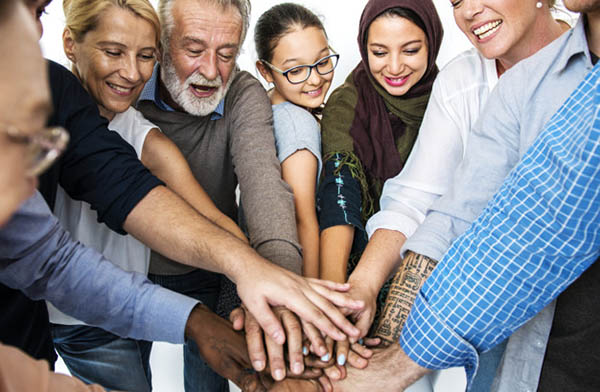 Creating A Community: It doesn’t matter where you come from or what religion you are. When we all come together, magical things happen.
Creating A Community: It doesn’t matter where you come from or what religion you are. When we all come together, magical things happen.
We spent a lot of time talking. We talk about everything and we look at it from all different angles. That ends up saving us time right in the end because we play through things. We both have good instincts. We both have different strengths and different ways of looking at things. Our allocation of that time is helpful. Sometimes we even start the day catching up personally, chatting and then going through. I get overwhelmed. I get paralyzed and I’ll be like, “Amy, I need to talk.” We’ll sit down and then we can prioritize. She’ll say, “Read me your list and we can prioritize.” It gives me a little better direction. Then it makes me feel like, “I’m going to take this one thing at a time and we’re going to be able to do that.” In the early months when it was so scary, typically neither one of us was down on the same day. We lucked out because usually, if one was down, one was up and could come up.
It’s becoming an accountability partner. There is some value and you go, “My partner is struggling today so I’m called to be better.”
Sometimes we have to emotionally charge each other too and that’s okay.
She’ll sing me the Laverne and Shirley song if I’m feeling down or High Hopes when she doesn’t have a headache.
I think about the process of talking and then the community. When you get a good idea, what do you do with it from the discussion and have mature into these ways have your discussions become more formalized?
I don’t think so.
We’ve had times where one of us have come in and had this great idea they think. Then when we start to process it and go through the steps of it or potential outcome, we’ll not necessarily do a no to each other but go through what are the good or the bad, the positive the negative. Then we go back to analyzing if it’s something we should be spending our time and our resources with. It has worked well for us. It’s helped us get along well and respect each other’s thoughts and ideas. Sometimes we try things out that the other thought of and it doesn’t work and a lot of times it does.
Then there are sometimes where we pick up on each other’s signals or vibe. All of a sudden, we’re on the same wavelength. We’re packaging something so perfectly and that happens more often than not.
My mom always used to tell me that you’ll know that something’s right if you’re looking at a house and you will get a rush, that’s what she would call it. That’s how we engage. It’s like, “I’m getting that feeling. I’m getting that rush.” We instinctively know that we’re on to something when we both have it.
What is most empowering is the fact that you can actually do something to make yourself feel better.
We also know each other’s looks. If we have a funny look at our faces, “Okay. Next.”
As you’ve done this, what do you think the biggest misconception about your organization is?
When we began, it was that a lot of people talk because people talk that we were trying to create a synagogue or a religious institution like a synagogue. We have tried to squelch that many times. We consider ourselves more like a youth group for adults. We laugh because we have our JTinis so we’re not a youth group. That has been our biggest misconception. We’re trying to create something out of the box, different and extraordinary. We’re doing it with feeling and the focus on creating relationships. It’s not so much about the end product of the event, it’s about how people felt when they left.
Sometimes they’re leaving high and sometimes they’re leaving touched. We had a worship service. We mentioned in our speech about the children and families who had been separated from one another at the borders. We both were terribly upset about that and we talked about it. Then we read a passage by Maya Angelou called Caged Bird. It was so fitting and perfect for that moment. Many of us had tears in her eyes thinking about all of the children or even our own children having that separation. We didn’t leave laughing. We left with a deep thought and not ignoring the situation but addressing it.
I was reading a piece put on by research from talking about the evolution of the aging population, and the lack of community. In creating the opportunity for some of the folks that outlive their spouse and go, “What are they going to do? Where are they going to go?” Their kids are everywhere nowadays instead of around. I think about the demographics of your organization. It would be interesting to see how many of them are past 60 and how many are sure 60.
They’re definitely a huge percentage of our population. You’re right on target with that.
It’s an interesting observation to see that need. The retirement nowadays, let’s say it’s 59 or 60. My great aunt lived 99 and a half. She goes, “Are you prepared for 39 years of the third act?”
The highest attrition rate within churches and synagogues, especially when they charge membership fees is among those empty nesters. They aren’t searching for opportunities for their children anymore. A lot of them don’t have endless resources. Paying membership fees that are in excess of $1,000 on a fixed income or on an income where you’re planning your golden years, that’s a lot. If they’re not using that on a regular basis they’re dropping in for a holiday or one or two occasions. It doesn’t fit those expenses with their needs. We’re catching something that’s resonating well with people. They do still want community, but they don’t want it to all be about coming to a service. They want to experience the social and emotional pieces.
I also wanted to address about misconceptions and misunderstandings. You don’t have to belong to a synagogue or come to JTown, you can do both. It’s meant to be an enhancement of people’s Jewish experience. It’s meant to be another gateway. Half our board are still members of synagogues and lots of people that come to our events are still members of synagogues. We’re just trying to find different ways for people to be together and maybe to capture some people that aren’t doing anything at all.
 Creating A Community: You’ll know that something’s special when you feel that rush.
Creating A Community: You’ll know that something’s special when you feel that rush.
The community decay for lack of a better term. We’re all busy. We need to do all these stuff. You wake up one day and you go, “I don’t know my neighbor.” You can go to the town square in small towns. When you get together in the morning and when you think about the hill that you’re climbing, what’s the day-to-day self-talk or internal dialogue that keeps you focused and charged up about pursuing this labor of love?
It’s remembering and reminding each other of the experiences that we’re offering. We have one couple who came for their very first time and it was right after Parkland. We did a special prayer for those people and their families and they headed into Denver from Parkland. It touched them. Immediately they’re in this new city and not they feel like they’re part of something. We do a lot of stuff that is for fun. Then you see people meet other people and you hear them talking about getting together another time. We’re reminding ourselves that each of these things are worth it all.
The great thing too about JTown is that you can pick and choose what you want to do with people that love the worship experience. Then we have this great dinner afterwards and they love that. We have some people who say, “Worship doesn’t necessarily resonate with me. I love that Project Our Town and I want to get involved with that. Where they may say, “I go to synagogue for worship, but I want to come to you for social.” That’s what we love is that people can pick and choose what’s comfortable for them.
Looking back over the past year or so, is there anything you guys should have said no to and if so, why?
We’ve been very fortunate. We don’t have to say no. We do the old preschool routine which is, “Don’t say no. Redirect.” We’ve done more of that. When somebody approaches us with an idea of partnership, we think it through. One of us won’t agree to something without talking to the other first of all. We do take time to think things through and think about potential outcomes to also put limits on what we can or cannot take on. It’s helped us in not necessarily say no but helping people to understand how it may or may not fit our mission.
We’re getting them involved. If this is the type of programming that you want, go find ten other families that want to do it, and we will do all the administration. We will set it up. We will do it with you and for you. That’s been a powerful message and then they can put their money where their mouth is. We’re lucky and I think different in away from most people who start a nonprofit organization. First of all, we’ve worked together before and for so many years. We’ve worked in jobs that prepared us to do this. A lot of times people are going to open a 501(c)(3) because they have a huge passion. Maybe they’ve lost somebody to a disease or it’s a cause that they’re just passionate about. We have all that, but we also have the professional experience. We’re ahead of the game in that way. We’re more easily able to say no when we should say no earlier on, as opposed to if we weren’t seasoned in what we’re doing.
Is there a quote that gets you going or one that you use frequently in your organization?
“Your vibe attracts your tribe.” Then also lately it’s been, “If you want to feel good, do good.” We’ve talked a lot about that over the last couple of months with Project Our Town as we’re all feeling down about what we see and where our lives are. It’s that empowerment that you can do something to make yourself feel better.
Do you have an unusual habit or something that you consider unusual?
I don’t think of an unusual habit. Cindy brings out the silliness, the joy and the happiness of having a work partner. We laugh a lot. We also sing and dance loud and funny. That’s what helps us enjoy coming together every day.
I’d say that’s a little unusual that you probably don’t see a lot.
No matter what’s happening, find the humor in it.
It’s not unusual for her.
Just take a break dance party.
It’s your turn. Does Amy have any unusual habits or maybe somebody else would consider unusual?
She has some pretty extraordinary characteristics that other people don’t have and that I don’t have. She oozes passion and it’s contagious. She’s good with people and with Project Our Town, she’s given me a few heart attacks because she started right off the bat with, “We’re going to have a thousand volunteers and a hundred projects.” I promised her she wouldn’t say a thousand anymore because it scares me. She’s ridiculously optimistic, but it’s turning out to be the truth. She also has a gift for making people feel special and cared for. That’s how she’s the executive director of a thousand-plus family synagogue. Everybody felt like they knew her because she just has this rambunctiously, loud friendly voice, she remembers you, and people love her.
We also make a good team because we have some different qualities than the other. Cindy is a communications and marketing guru. From the very beginning, she helped us develop our brand. A lot of what we represent is because Cindy could package it for us in a way that made sense. She has this wonderful gift of not only bringing out the very best of people, even when they’re down. She can help them see something terrific about themselves. Also being able to approach things from, “What do we think people want to hear? If I’m to read this what do I want to read?” It has helped us a lot. We have people say our marketing and our communication is so unique and very powerful. That’s because of Cindy. We have a great relationship.
Who knew you had such antennas that you could link into all of these?
I was raised that no matter what’s happening, you find humor. It’s a huge part of life. Also that there’s always something to be grateful for. I tried to do that and I try to push it on Amy.
She’s great about that.
If she won’t smile then I’ll have to do something crazy to get her to smile, but I’ll eventually get her to laugh.
Looking back, is there a failure or apparent failure that you guys think has helped propel the success of the organization now?
 Creating A Community: Your vibe attracts your tribe.
Creating A Community: Your vibe attracts your tribe.
It’s not a failure per se, but we left our previous place of employment with a lot of goals that we weren’t able to finish. A lot of passion that we didn’t know where to put when we left. There’s a lot of pain and a lot of loss on many different levels. I think that it did end up, I think a mistake could be that we maybe sat in it too long. In the end, it’s turned out to help us along the way. I think our bond is even stronger because of it, and to be able to go through stuff together is obviously easier than alone. We both had the same passion and nowhere to put it at the exact same time. These skills were like crazy meant to be, maybe. It’s like we didn’t know where to put it. That’s when we first talked about it. We were finding jobs that we wanted. It was like, “I don’t know where to put all this passion because we were just so in.” We were able to find a place to put it.
Thinking about somebody in our audience, “I want to do something like that,” like what you guys are doing in my community. What advice would you guys offer to that person?
First of all, we already talked about having the right support. All nonprofits rely on volunteers to some degree. Laypeople or volunteers whatever you want to call it, you have to share your passion. You also need to make it very worthwhile for that person or those people. To me, for instance with Project Our Town, we have this great end-goal in mind. 1,000, 80 projects, whatever it’s going to be an impact of a lot of people. For our leadership committee and for all the people who are engaged in working on it, to me, it’s also the process they take the road they take with us. That’s important. The process is as important as the end result in a way because if you engage those volunteers and they see the passion, they also have fun doing it. If they get true meaning from it, they’re going to do it again.
There’s nothing worse than having a one and done with volunteers. The biggest compliment to us will be when we start again with Project Our Town to have those same people return.
I think on a more practical side, it’s hard. It’s so worthwhile, but it’s hard. They should plan on not getting paid more than peanuts for at least a year. It would be hard to do alone unless you’re good at a lot of things. Even the 501(c)(3) paperwork, it was so daunting. Luckily, we had people on our board with experience, so we were able to get a little help with that. Filling out grants if you’ve never done it before is so daunting. Gathering up a gang of people with different strengths is important, and it takes a long time. We are lucky and I think unusual with how fast it all happened. To us, it’s even felt like it’s taken a long time.
As our president, Sheryl, would say that it’s having a strategic plan for each aspect of what you’re doing. It’s not a quick, “I’m going to go this path or make this program work.” You have to think through and have some concrete ideas behind it.
If you have ten people come to a program, you’ve got to meet those ten people have the greatest time at that program and walk away being happy even if you have hope that you would have 50. Small differences matter. As long as you’re meeting your mission, you don’t need to go in and kick off with being able to raise $500,000 for whatever cause it is. Being able to do a gala there’s no way we could do like an annual gala. We’re nowhere near that. If you can do something that makes a difference even one person’s life that joins you, then you are doing your mission and you’ll get there. You have to be fulfilled by that.
If people wanted to reach out to you, how do they find you on social media?
For Project Our Town we have ProjectOurTown.org. Email is Info@ProjectOurTown.org. Then JTown is JTownCo.org and then Info@JTownCo.org. We’re pretty easy to find. We’ve got our domains there. We’ve got our trademarks on the way too.
Cindy has it all arranged for us. Those are the skills that we have to have and she has them. She designed our website she designed everything we do.
There’s a whole business side of it. Even before you’re a nonprofit status you have to know how to put together a board. You have to have your bylaws done. You have to have all of this paperwork filed. It’s like a business. Luckily Amy knew how to do a lot of that. Sometimes we sit on a Secretary of State’s website with this forum we’re supposed to fill out. It’s like, “What does this mean?” Then you have to pay $50 if you fill it out wrong and you have to redo it. Just a little tip.
Cindy and Amy, I can’t tell you how much I appreciate you taking the time to share your success and your aspirations. Thank you for helping out the community.
Thank you for this wonderful opportunity with us and for us. It’s an honor to share what we’re doing.
Links Mentioned:
About Cindy Abramson
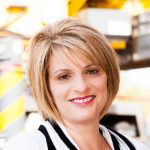 Cindy Abramson has been a communications consultant for many years, working for businesses, non-profit organizations, and individuals on creation of promotional materials, marketing collateral documents, branding, editing, writing, and website (concept, content creation, and management). She has co-written and published two books (one is a national book award winner).
Cindy Abramson has been a communications consultant for many years, working for businesses, non-profit organizations, and individuals on creation of promotional materials, marketing collateral documents, branding, editing, writing, and website (concept, content creation, and management). She has co-written and published two books (one is a national book award winner).
For more than ten years, Cindy worked for Temple Sinai in Denver as Religious School Assistant Principal, Assistant Executive Director and, most recently, Communications Director.
Cindy is a third generation Denver native. She and her husband, Rob have 4 children and 6 grandchildren between them.
About Amy Becker
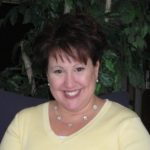 Amy Becker grew up in Denver and from her early years as a teenager was involved in Jewish community activities. After college, Amy was appointed as the Regional Director of Rocky Mountain Region B’nai B’rith Youth Organization, supervising programming for over 400 teens in Colorado, Wyoming and New Mexico.
Amy Becker grew up in Denver and from her early years as a teenager was involved in Jewish community activities. After college, Amy was appointed as the Regional Director of Rocky Mountain Region B’nai B’rith Youth Organization, supervising programming for over 400 teens in Colorado, Wyoming and New Mexico.
Following her youth experience, Amy was hired as the Director of Programming for Temple Sinai in 1994 and for the next 23 years, she served not only in this role but also as the Preschool Director, Assistant Executive Director and finally the Executive Director. Clearly, she had an affinity for serving the Denver Jewish community.
Amy has a wonderful and supportive husband of 17 years, Jeff, who volunteers at her side. They have twin teenagers, Corey and Chelsea, who also are committed to social action activities and Jewish youth programming in the community.
Love the show? Subscribe, rate, review, and share!
Join the Business Leaders Podcast Community today:
- businessleaderspodcast.com
- Business Leaders Facebook
- Business Leaders Twitter
- Business Leader LinkedIn
- Business Leaders YouTube
The post Cindy Abramson and Amy Becker: Creating A Community For Interfaith Families With JTown appeared first on My podcast website.